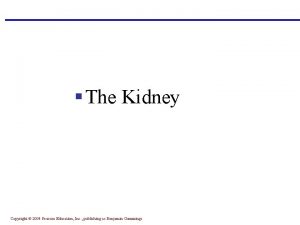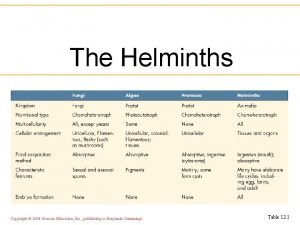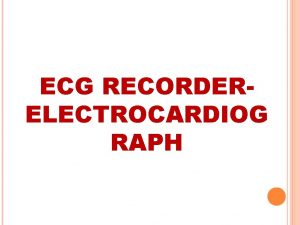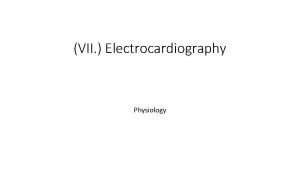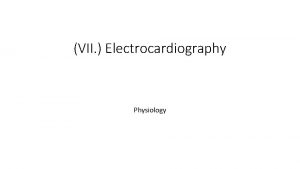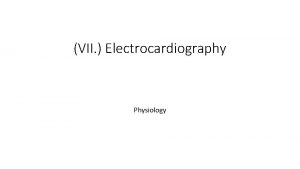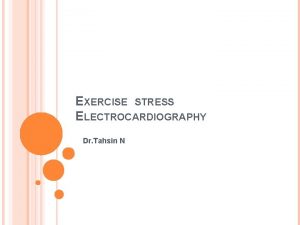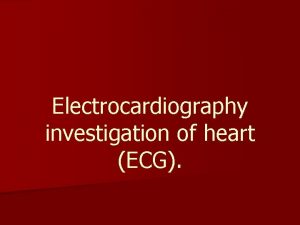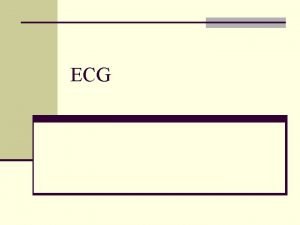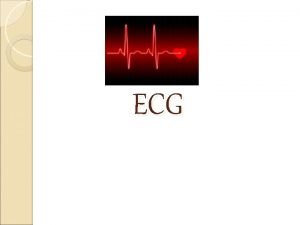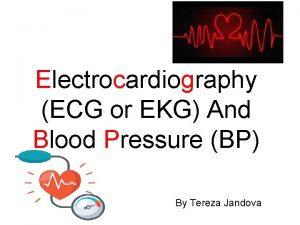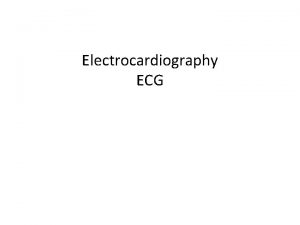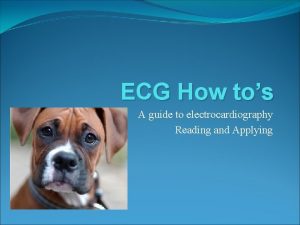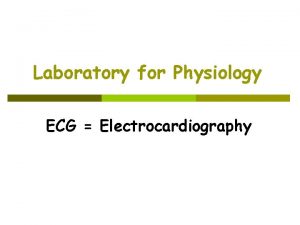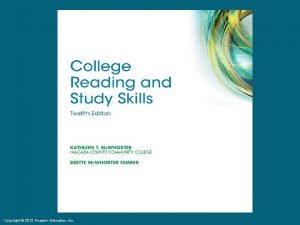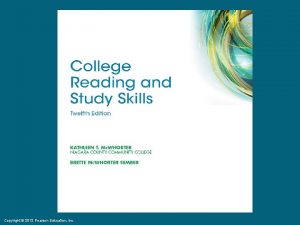ECG Electrocardiography Exercise 31 Copyright 2004 Pearson Education




















- Slides: 20

ECG: Electrocardiography Exercise 31 Copyright © 2004 Pearson Education, Inc. , publishing as Benjamin Cummings

Cardiac Muscle Contraction § Heart muscle: § Is stimulated by nerves and is self-excitable (automaticity) § Contracts as a unit § Has a long (250 ms) absolute refractory period § Cardiac muscle contraction is similar to skeletal muscle contraction Copyright © 2004 Pearson Education, Inc. , publishing as Benjamin Cummings

Heart Physiology: Intrinsic Conduction System § Autorhythmic cells: § Initiate action potentials § Have unstable resting potentials called pacemaker potentials § Use calcium influx (rather than sodium) for rising phase of the action potential Copyright © 2004 Pearson Education, Inc. , publishing as Benjamin Cummings

Heart Physiology: Sequence of Excitation § Sinoatrial (SA) node generates impulses about 75 times/minute § Atrioventricular (AV) node delays the impulse approximately 0. 1 second § Impulse passes from atria to ventricles via the atrioventricular bundle (bundle of His) Copyright © 2004 Pearson Education, Inc. , publishing as Benjamin Cummings

Heart Physiology: Sequence of Excitation § AV bundle splits into two pathways in the interventricular septum (bundle branches) § Bundle branches carry the impulse toward the apex of the heart § Purkinje fibers carry the impulse to the heart apex and ventricular walls Copyright © 2004 Pearson Education, Inc. , publishing as Benjamin Cummings

Heart Physiology: Sequence of Excitation Copyright © 2004 Pearson Education, Inc. , publishing as Benjamin Cummings Figure 18. 14 a

Heart Excitation Related to ECG Figure 18. 17 Copyright © 2004 Pearson Education, Inc. , publishing as Benjamin Cummings

Extrinsic Innervation of the Heart § Heart is stimulated by the sympathetic cardioacceleratory center § Heart is inhibited by the parasympathetic cardioinhibitory center Copyright © 2004 Pearson Education, Inc. , publishing as Benjamin Cummings Figure 18. 15

Electrocardiography § Electrical activity is recorded by electrocardiogram (ECG) § P wave corresponds to depolarization of SA node § QRS complex corresponds to ventricular depolarization § T wave corresponds to ventricular repolarization § Atrial repolarization record is masked by the larger QRS complex Inter. Active Physiology®: Cardiovascular System: Intrinsic Conduction System Copyright © 2004 Pearson Education, Inc. , publishing as Benjamin Cummings

Electrocardiography Figure 18. 16 Copyright © 2004 Pearson Education, Inc. , publishing as Benjamin Cummings

Heart Sounds § Heart sounds (lub-dup) are associated with closing of heart valves § First sound occurs as AV valves close and signifies beginning of systole § Second sound occurs when SL valves close at the beginning of ventricular diastole Copyright © 2004 Pearson Education, Inc. , publishing as Benjamin Cummings

Cardiac Cycle § Cardiac cycle refers to all events associated with blood flow through the heart § Systole – contraction of heart muscle § Diastole – relaxation of heart muscle Copyright © 2004 Pearson Education, Inc. , publishing as Benjamin Cummings

Phases of the Cardiac Cycle Figure 18. 20 Copyright © 2004 Pearson Education, Inc. , publishing as Benjamin Cummings

Regulation of Heart Rate: Autonomic Nervous System § Sympathetic nervous system (SNS) stimulation is activated by stress, anxiety, excitement, or exercise § Parasympathetic nervous system (PNS) stimulation is mediated by acetylcholine and opposes the SNS § PNS dominates the autonomic stimulation, slowing heart rate and causing vagal tone Copyright © 2004 Pearson Education, Inc. , publishing as Benjamin Cummings

Abnormal Rhythms Copyright © 2004 Pearson Education, Inc. , publishing as Benjamin Cummings

Abnormal Rhtyhms PVC: premature ventricular contraction Copyright © 2004 Pearson Education, Inc. , publishing as Benjamin Cummings

Ventricular tachycardia: one potentially fatal arrhythmia V-tach can reach a rate where the it is “non-perfusing”. At this point, defibrillation is appropriate Copyright © 2004 Pearson Education, Inc. , publishing as Benjamin Cummings

Heart Attack! Copyright © 2004 Pearson Education, Inc. , publishing as Benjamin Cummings

Terms § Normal Sinus Rhythm – NSR, all wave forms present and normal § Fibrillation – irregular rhythm of uncoordinated contractions. V-fib (ventricular fibrillation) results in making the heart useless as a pump. § Bradycardia – HR <60 bpm § Tachycardia – HR >100 bpm § Non-perfusing tachycardia – HR that is so rapid that the ventricles don’t fill between contractons Copyright © 2004 Pearson Education, Inc. , publishing as Benjamin Cummings

That’s it. Copyright © 2004 Pearson Education, Inc. , publishing as Benjamin Cummings
 Pearson education
Pearson education 2004 pearson education benjamin cummings
2004 pearson education benjamin cummings Pearson education ltd
Pearson education ltd Copyright by pearson education inc. answers
Copyright by pearson education inc. answers 2010 pearson education inc
2010 pearson education inc Copyright 2009
Copyright 2009 2018 pearson education inc
2018 pearson education inc 2014 pearson education inc
2014 pearson education inc Copyright 2010 pearson education inc
Copyright 2010 pearson education inc Copyright 2010 pearson education inc
Copyright 2010 pearson education inc Copyright by pearson education inc. answers
Copyright by pearson education inc. answers 2008 pearson education inc
2008 pearson education inc Copyright 2009 pearson education inc
Copyright 2009 pearson education inc 2015 pearson education inc
2015 pearson education inc Copyright 2010 pearson education inc
Copyright 2010 pearson education inc Copyright 2010 pearson education inc
Copyright 2010 pearson education inc Copyright 2010 pearson education inc
Copyright 2010 pearson education inc 2010 pearson education inc
2010 pearson education inc Copyright 2010 pearson education inc
Copyright 2010 pearson education inc Copyright 2010 pearson education inc
Copyright 2010 pearson education inc Copyright 2010 pearson education inc
Copyright 2010 pearson education inc
